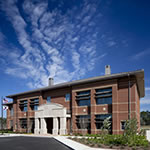Rapid population growth in Florida has resumed post-recession, but building to accommodate that growth threatens some of the natural land features that make the Sunshine State so attractive in the first place. Which is why educational institutions such as Pensacola State College have begun taking wetland preservation into account when expanding their campuses.
Designed by Pensacola-based architecture firm Bullock Tice Associates (BTA), the college’s South Santa Rosa Center campus master plan calls for four buildings to eventually be built on property donated from an estate in Gulf Breeze, Florida. About half the acreage is covered with bogs—a type of isolated wetland underlined with natural clay that blocks percolation—and populated by stub-knee cypress trees and a salamander species unique to the region. Isolated bogs, not fed by other water sources, are not regulated by the state, but one of the bogs on-site drains into the Santa Rosa Sound on the Gulf of Mexico, making it subject to state EPA protections. Thus, Pensacola State’s master plan and first building, completed in 2013, take into account its distinct natural landscape.
Rather than look upon these wetlands as developmental hindrances, BTA treated them as assets. “The school administrators were very conscious of the wetland and discussed it as an educational feature,” says Larry Adams Jr., an associate partner with the firm. “Situated between the academic buildings, access roads, and US Highway 98, the bogs create a buffer.”
Still, with surface parking and four planned structures, stormwater runoff in the hurricane-prone location needed to be managed. BTA added stormwater retention ponds that employ a filtering system for overflow. Due to the natural clay, that water does not drain and is instead harvested for landscape irrigation. Fountains in each of the two ponds provide necessary aeration as well as a visual treat for students and faculty. Should a dry spell occur, the campus will draw greywater off a nearby reclaimed water treatment facility, eliminating any need for potable water to be used for landscaping.
In addition to nature-sensitive siting, the first campus building is a LEED Gold-certified structure with features that nod to other environmental concerns. The building envelope is tight—air-conditioning is typically used 12 months of the year here—and efficient lighting fixtures that include sensors and timers are used throughout the 32,000-square-foot, two-story facility.
A strategic use of all that sunshine is the lynchpin to how this building works so well as a teaching facility. Deeply inset windows allow larger sun exposures, contributing to less electrical energy consumption but also providing the psychological benefits attributed to natural light. To mitigate the hottest sunshine in summer months and control the amount of light that enters, exterior solar shading devices were incorporated into the window wells. “Direct sunlight would be too much,” says Johnny Fortune, BTA’s expert on building information modeling (BIM), who employed sun-tracking software to set the angles and depths of the window shades.
Two shades adorn each window, positioned midway and three-quarters up on each window instead of protruding awning-like, as seen on many other buildings. “This allows the building overall to look more collegiate,” Adams says, adding that they are also less vulnerable in storms. As an added benefit, they bounce sunlight off interior ceilings, providing an indirect lighting source to students and faculty.
Interior materials and finishes made of recycled content include structural steel, the foundation, and carpeting. One type of floor tile used, EcoCycle by Crossville, contains an antimicrobial material and is dust resistant, which reduces the amount of cleaning required.
During the construction phase in Pensacola, the wetlands and mature trees were barricaded and buffered for protection, and heavy vehicles followed prescribed routes to minimize damage to the natural landscape. After heavy rainfalls, state officials inspected the site to ensure that runoff did not affect the natural wetlands. They found that the salamanders survived and might serve as a teaching tool for generations of students to come.


